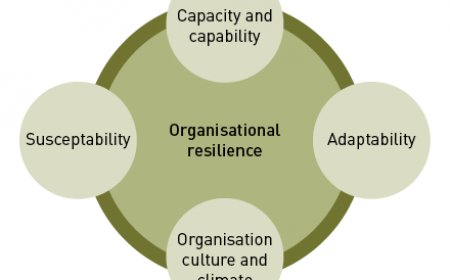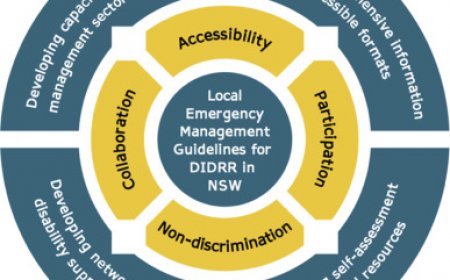Australia Upskilling Guide for 2025
Discover the ultimate Australia Upskilling Guide for 2025 , covering trends, strategies, and resources to future-proof your career and stay ahead in the evolving job market.
In an era where technological advancements and global economic shifts are reshaping industries at an unprecedented pace, upskilling has become a critical necessity for individuals and businesses alike. As we approach 2025 , the Australian workforce is poised to undergo significant transformations driven by automation, artificial intelligence (AI), and the increasing demand for specialized skills. This guide serves as a comprehensive roadmap to navigating the landscape of upskilling in Australia , offering actionable insights and strategies tailored to the unique needs of professionals, employers, and policymakers.
The concept of upskilling extends beyond mere training; it encompasses a holistic approach to enhancing one's capabilities, fostering adaptability, and ensuring long-term career resilience. In this article, we delve into the multifaceted dimensions of upskilling , exploring its importance, identifying key trends, and providing practical steps to thrive in the evolving job market. Whether you are an individual seeking to future-proof your career or an organization aiming to remain competitive, this guide equips you with the knowledge and tools necessary to succeed.
Australia’s economy is undergoing a profound transformation, with industries such as healthcare, information technology, construction, and renewable energy experiencing rapid growth. However, these sectors also face acute skill shortages, exacerbated by the rapid pace of technological innovation. For instance, AI-driven automation is replacing repetitive tasks in manufacturing, while the demand for advanced digital literacy is skyrocketing across all sectors. To address these challenges, both individuals and organizations must adopt a proactive approach to upskilling .
This guide is structured to provide a deep dive into the nuances of upskilling in Australia. We begin by examining why upskilling is essential for the Australian workforce, followed by an exploration of the key trends shaping the labor market in 2025 . Next, we outline government initiatives designed to support workforce development, highlight industry-specific opportunities, and discuss effective strategies for implementing upskilling programs. Finally, we address common barriers to upskilling and offer solutions to overcome them.
By the end of this article, readers will have a clear understanding of how to navigate the complexities of upskilling and position themselves for success in the dynamic job market of 2025 . Let us embark on this journey together, unlocking the potential of Australia’s workforce through continuous learning and professional growth.
Why Upskilling is Essential for Australia’s Workforce
1. The Impact of Automation and AI
Automation and artificial intelligence are revolutionizing industries across Australia, from manufacturing to healthcare. These technologies enhance efficiency, reduce costs, and improve accuracy in various processes. However, they also displace certain roles, particularly those involving repetitive or manual tasks. According to a report by the Australian Industry Group , approximately 46% of jobs in Australia are at risk of being partially or fully automated by 2025 . This underscores the urgent need for workers to acquire new competencies and refine existing ones to remain employable.
For example, in the manufacturing sector, robots are increasingly handling assembly line tasks that were once performed by humans. While this shift improves productivity, it leaves many workers without viable employment options unless they upskill to operate and maintain these advanced systems. Similarly, in the finance industry, AI-powered algorithms are automating routine tasks like data entry and transaction processing, necessitating a shift toward higher-value activities such as financial analysis and strategic planning.
2. Addressing Skill Shortages
Australia is grappling with significant skill shortages in several high-demand sectors. For instance, the healthcare industry faces a critical shortage of qualified nurses, doctors, and allied health professionals due to an aging population and increased demand for medical services. Similarly, the IT sector struggles to find talent proficient in cybersecurity, cloud computing, and software development. By prioritizing upskilling , individuals can bridge these gaps and secure lucrative careers in emerging fields.
Employers also benefit from investing in upskilling their workforce. A study conducted by Deloitte Access Economics found that companies that prioritize employee training experience a 24% higher profit margin compared to those that do not. Upskilling not only enhances productivity but also boosts employee morale and retention rates, creating a win-win scenario for both parties.
3. Supporting Economic Growth
From a macroeconomic perspective, upskilling contributes significantly to Australia’s productivity and innovation capacity. A skilled workforce attracts foreign investment, fosters entrepreneurship, and drives sustainable growth. For example, the renewable energy sector is expected to create over 44,000 new jobs by 2025 , according to the Clean Energy Council . Workers equipped with green skills—such as expertise in solar panel installation, wind turbine maintenance, and energy-efficient building design—are well-positioned to capitalize on these opportunities.
Moreover, upskilling aligns with Australia’s broader economic goals, including reducing unemployment, narrowing the gender pay gap, and promoting social inclusion. Programs targeting disadvantaged groups, such as Indigenous Australians and migrants, ensure that everyone has access to the resources needed to thrive in the modern economy.
4. Enhancing Career Resilience
Individuals who invest in upskilling are better equipped to navigate the uncertainties of the job market. In an era where job security is no longer guaranteed, adaptability and lifelong learning are essential for career longevity. For instance, professionals who acquire digital literacy skills can seamlessly transition between roles and industries, even as traditional jobs become obsolete.
Upskilling also empowers workers to pursue entrepreneurial ventures. With access to online platforms, e-commerce tools, and digital marketing resources, individuals can launch startups or side businesses, diversifying their income streams and achieving greater financial independence.
Key Trends Shaping Upskilling in 2025
1. The Rise of Automation and AI
As mentioned earlier, automation and AI are transforming industries across Australia. While these technologies eliminate certain roles, they also create new opportunities in areas such as machine learning, robotics engineering, and AI ethics. To prepare for this shift, workers must focus on acquiring skills that complement automation, such as creativity, emotional intelligence, and complex problem-solving.
For example, in the retail sector, AI-powered chatbots handle customer inquiries, freeing human employees to focus on relationship-building and personalized service. Similarly, in logistics, autonomous vehicles streamline transportation processes, allowing workers to specialize in route optimization and supply chain management.
2. Demand for Green Skills
Australia’s commitment to achieving net-zero emissions by 2050 has sparked a surge in demand for green skills . These competencies encompass a wide range of disciplines, including renewable energy, sustainable agriculture, waste management, and environmental policy. Workers who possess green skills are highly sought after by employers seeking to align with global sustainability standards.
One notable example is the construction industry, which is increasingly adopting eco-friendly practices such as modular building techniques and low-carbon materials. Upskilling in this domain enables workers to contribute to environmentally responsible projects while commanding higher salaries.
3. Remote Work Competencies
The COVID-19 pandemic accelerated the adoption of remote work, a trend that continues to gain momentum. Employees must now master digital communication platforms, project management software, and virtual collaboration techniques. Additionally, soft skills such as time management, self-motivation, and cross-cultural communication have gained prominence.
Organizations that invest in upskilling their workforce in these areas are better equipped to thrive in a decentralized work environment. For instance, companies that train employees in agile methodologies and remote leadership principles can maintain productivity and cohesion, regardless of physical location.
4. Data-Driven Decision Making
Data literacy has emerged as a cornerstone of modern business operations. From marketing to finance, professionals who can analyze and interpret data are in high demand. Upskilling programs that emphasize statistical analysis, machine learning, and data visualization empower workers to make informed decisions, driving organizational success.
Consider the healthcare sector, where predictive analytics helps hospitals optimize resource allocation and improve patient outcomes. Nurses and doctors trained in data interpretation can leverage these insights to deliver more personalized care, enhancing both efficiency and quality.
5. Lifelong Learning Culture
The notion of education ending after formal schooling is becoming obsolete. A culture of lifelong learning is taking root, with individuals pursuing continuous education through online courses, workshops, and certifications. Employers play a pivotal role in fostering this mindset by offering access to learning resources and incentivizing skill acquisition.
Platforms like Coursera , Udemy , and LinkedIn Learning have democratized education, enabling anyone with an internet connection to acquire new skills. Governments and educational institutions are also partnering to develop affordable, accessible programs that cater to diverse learner needs.
Government Initiatives Supporting Upskilling in Australia
Recognizing the transformative power of upskilling , the Australian government has launched several initiatives to support workforce development. These programs aim to address skill shortages, promote inclusivity, and prepare citizens for the jobs of tomorrow.
JobTrainer Fund
The JobTrainer Fund provides free or low-cost training opportunities in high-demand sectors such as healthcare, IT, and construction. By partnering with vocational institutions and private providers, the fund ensures that Australians have access to quality education tailored to current market needs. Since its inception, the program has helped thousands of individuals acquire valuable skills and secure stable employment.
Skills for Education and Employment (SEE) Program
Targeting disadvantaged groups, the SEE Program focuses on improving foundational skills like literacy, numeracy, and digital proficiency. Participants receive personalized support to overcome barriers to employment, enabling them to pursue higher-level qualifications and secure stable careers. The program has been particularly effective in empowering women, Indigenous Australians, and migrants.
Apprenticeship Boost
To address the shortage of skilled tradespeople, the government introduced the Apprenticeship Boost initiative. This program offers financial incentives to employers who hire apprentices, encouraging hands-on learning and skill development in critical industries. Apprenticeships provide a pathway for young Australians to enter the workforce while gaining practical experience.
National Skills Commission
Established to monitor labor market trends, the National Skills Commission plays a vital role in shaping policy decisions. By analyzing data on skill demands and workforce dynamics, the commission identifies priority areas for investment and guides the design of targeted upskilling programs. Its research informs both public and private sector initiatives, ensuring alignment with national objectives.
Industry-Specific Upskilling Opportunities
Different sectors face unique challenges and opportunities when it comes to upskilling . Below, we explore how various industries in Australia are adapting to the changing landscape.
Healthcare and Aged Care
With an aging population and advancements in medical technology, the healthcare sector requires a steady influx of skilled professionals. Upskilling initiatives focus on areas such as telemedicine, patient care management, and health informatics. Nurses, doctors, and allied health workers benefit from specialized training programs that enhance their ability to deliver high-quality care.
For example, telehealth platforms enable patients in remote areas to consult with specialists without traveling long distances. Healthcare workers trained in telemedicine protocols can expand their reach and improve accessibility for underserved communities.
Information Technology
The IT industry is characterized by rapid innovation, necessitating constant upskilling . Cybersecurity, cloud computing, and software development are among the most sought-after skills. Companies often collaborate with educational institutions to offer internships, boot camps, and certification courses, ensuring employees stay ahead of technological trends.
One notable trend is the rise of DevOps—a methodology that combines software development and IT operations. Professionals skilled in DevOps can streamline workflows, reduce errors, and accelerate product delivery, making them invaluable assets to tech companies.
Construction and Infrastructure
As Australia embarks on large-scale infrastructure projects, the demand for skilled labor in construction is surging. Upskilling efforts target emerging areas such as smart building technologies, sustainable materials, and project management methodologies. Workers equipped with these competencies contribute to safer, more efficient project execution.
For instance, Building Information Modeling (BIM) software allows architects and engineers to create detailed 3D models of structures before construction begins. Training in BIM enhances precision and reduces costly rework, benefiting both contractors and clients.
Retail and Hospitality
The retail and hospitality sectors are undergoing digital transformation, with e-commerce and contactless services gaining traction. Upskilling programs emphasize customer experience design, digital marketing, and supply chain optimization. Employees trained in these areas help businesses adapt to changing consumer preferences and operational requirements.
Consider the hospitality industry, where mobile apps and loyalty programs enhance guest experiences. Staff trained in digital engagement strategies can leverage these tools to build stronger relationships and drive repeat business.
Strategies for Effective Upskilling
To maximize the benefits of upskilling , individuals and organizations must adopt strategic approaches. Here are some proven methods to ensure successful outcomes:
Personalized Learning Plans
Every learner has unique strengths and weaknesses. Creating a personalized plan allows individuals to focus on areas that align with their career goals and interests. Employers can facilitate this process by conducting skills assessments and offering tailored training options.
For example, a software developer interested in transitioning to data science might enroll in courses on Python programming, machine learning, and statistical analysis. A customized roadmap ensures they acquire relevant skills efficiently.
Blended Learning Models
Combining traditional classroom instruction with online resources creates a flexible and engaging learning experience. Blended models accommodate diverse learning styles and enable participants to progress at their own pace while benefiting from peer interaction and expert guidance.
Many universities and vocational schools now offer hybrid programs that blend in-person lectures with virtual labs and discussion forums. This format appeals to busy professionals who require flexibility without sacrificing quality.
Micro-Credentials and Certifications
Micro-credentials provide bite-sized, focused learning experiences that validate specific competencies. These credentials are ideal for professionals seeking to acquire niche skills without committing to lengthy degree programs. They also serve as valuable additions to resumes, signaling expertise to potential employers.
Examples include Google’s IT Support Professional Certificate and Microsoft’s Azure Fundamentals certification. Both programs are widely recognized and can open doors to lucrative careers in tech.
Mentorship and Peer Support
Learning does not occur in isolation. Mentorship programs connect experienced professionals with novices, fostering knowledge exchange and networking opportunities. Similarly, peer support groups encourage collaboration and accountability, enhancing the overall effectiveness of upskilling efforts.
For instance, a junior marketer paired with a seasoned executive can learn best practices, avoid common pitfalls, and gain insights into industry trends. Regular check-ins ensure consistent progress and mutual growth.
Continuous Feedback and Evaluation
Regular feedback helps learners track their progress and identify areas for improvement. Employers should implement robust evaluation systems that measure both quantitative metrics (e.g., course completion rates) and qualitative factors (e.g., application of new skills in real-world scenarios).
Performance reviews, 360-degree feedback, and competency assessments provide actionable insights, enabling individuals to refine their skills and achieve desired outcomes.
Overcoming Barriers to Upskilling
Despite its numerous advantages, upskilling faces several obstacles that must be addressed to achieve widespread adoption.
Financial Constraints
The cost of training programs can deter individuals, especially those from low-income backgrounds. Scholarships, subsidies, and employer-sponsored initiatives alleviate this burden, making education more accessible.
For example, the Victorian Government offers fee-free TAFE courses in priority areas such as nursing, plumbing, and cybersecurity. These programs remove financial barriers and encourage participation.
Time Management Challenges
Balancing work, family, and study commitments poses a significant challenge for many learners. Flexible scheduling, part-time options, and asynchronous learning formats cater to busy lifestyles, enabling participants to integrate upskilling into their daily routines.
Online platforms like FutureLearn and edX allow users to learn at their own pace, completing modules whenever convenient. This flexibility accommodates diverse schedules and maximizes engagement.
Resistance to Change
Some workers may resist adopting new technologies or methodologies due to fear of failure or uncertainty about relevance. Clear communication of the benefits, coupled with supportive environments, encourages openness to change and fosters a growth mindset.
Leadership plays a crucial role in overcoming resistance. Managers who model lifelong learning behaviors inspire their teams to embrace upskilling as a natural part of professional development.
Lack of Awareness
Many individuals are unaware of available upskilling opportunities or underestimate their importance. Public awareness campaigns, workplace seminars, and community outreach programs play a crucial role in disseminating information and inspiring action.
Social media platforms, webinars, and industry conferences are effective channels for raising awareness. Collaborations between governments, businesses, and educational institutions amplify reach and impact.
Accessibility
Ensuring equitable access to upskilling resources is paramount. Governments, educational institutions, and businesses must collaborate to remove barriers and create inclusive learning ecosystems. This includes providing accommodations for people with disabilities, offering multilingual content, and leveraging technology to reach remote and underserved populations.
For instance, Deakin University offers a range of online courses with built-in accessibility features, such as screen reader compatibility and captioned videos. These innovations ensure that all learners, regardless of background, can participate fully in the upskilling process.
How to Get Started with Upskilling
Embarking on an upskilling journey requires careful planning and commitment. Follow these steps to set yourself up for success:
- Assess Your Current Skills : Identify strengths and weaknesses using self-evaluation tools or professional assessments.
- Set Clear Goals : Define what you want to achieve through upskilling , whether it’s a promotion, career transition, or enhanced job satisfaction.
- Research Available Programs : Explore online courses, workshops, and certifications that align with your objectives.
- Create a Schedule : Allocate dedicated time for learning activities, balancing them with other responsibilities.
- Seek Support : Engage mentors, join study groups, and utilize employer-provided resources to stay motivated and accountable.
Conclusion
The future of work in Australia hinges on our collective ability to embrace upskilling . By staying informed, proactive, and adaptable, individuals and organizations can navigate the challenges and seize the opportunities presented by a rapidly evolving job market. This guide has provided a comprehensive overview of the trends, strategies, and resources available to support your upskilling journey. Now is the time to take action and position yourself for success in 2025 and beyond.
10 FAQ’s with Answers
-
What is upskilling?
Upskilling refers to the process of acquiring new or enhancing existing skills to remain competitive in the job market. -
Why is upskilling important in Australia?
It addresses skill shortages, supports economic growth, and prepares workers for emerging industries. -
Which industries require upskilling the most?
Healthcare, IT, construction, and retail are among the sectors with the highest demand for upskilled workers. -
Are there government programs for upskilling?
Yes, initiatives like the JobTrainer Fund and Apprenticeship Boost provide financial assistance and training opportunities. -
How can I start upskilling?
Begin by assessing your skills, setting goals, and enrolling in relevant courses or certifications. -
What are micro-credentials?
Micro-credentials are short, focused courses that certify specific competencies. -
Is upskilling expensive?
Costs vary, but many affordable or free options exist, including government-funded programs. -
Can upskilling improve my salary?
Yes, acquiring in-demand skills often leads to promotions, raises, and better job prospects. -
How long does upskilling take?
Duration depends on the program and individual pace, ranging from weeks to months. -
What skills will be in demand by 2025?
Digital literacy, data analysis, green skills, and soft skills like communication and adaptability will be highly valued.
What's Your Reaction?
 Like
0
Like
0
 Dislike
0
Dislike
0
 Love
0
Love
0
 Funny
0
Funny
0
 Angry
0
Angry
0
 Sad
0
Sad
0
 Wow
0
Wow
0











































